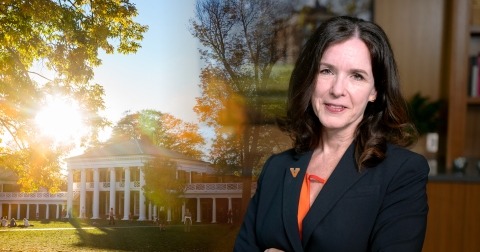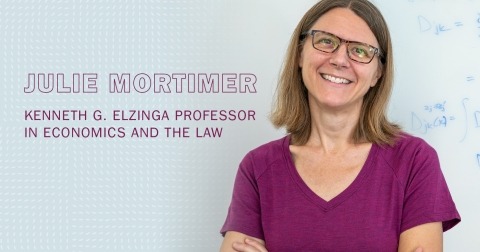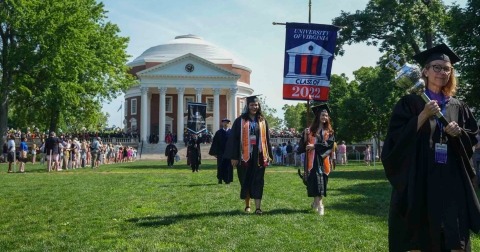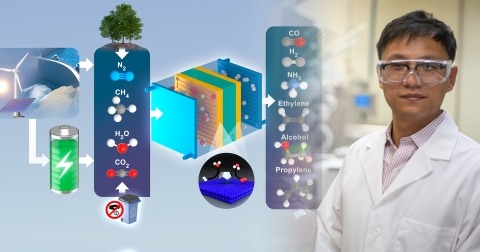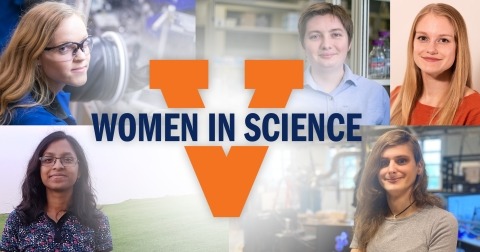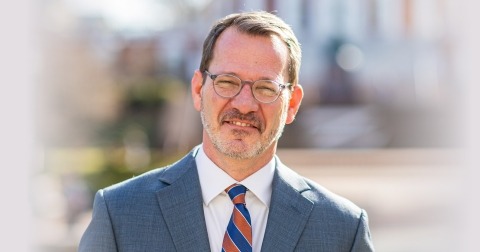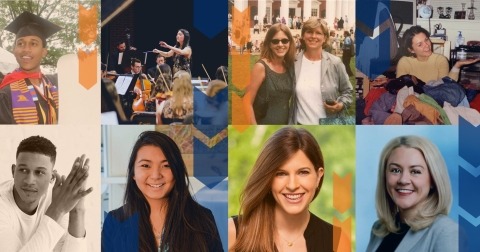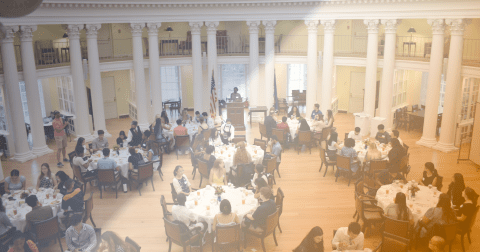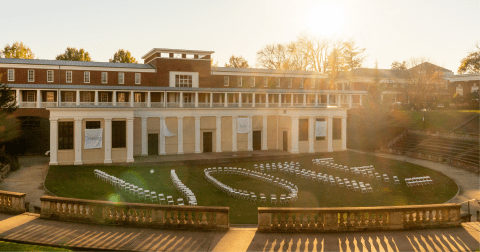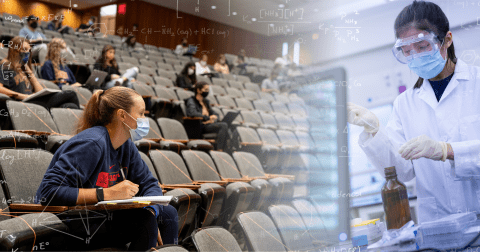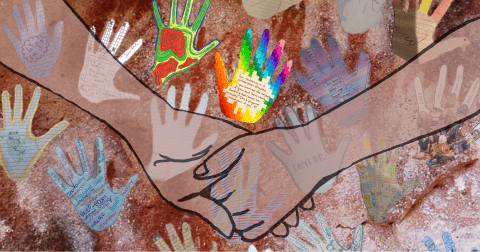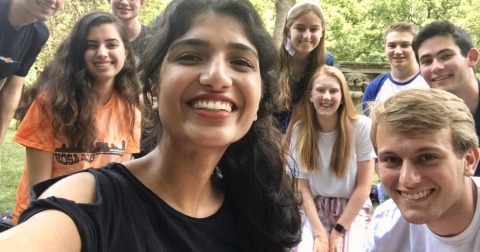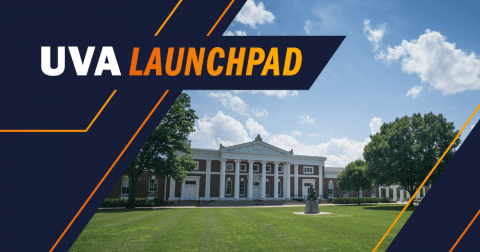As a graduate student in UVA’s Department of Biology, Jianhua “JC” Cang spent much of his time conducting experiments in the shielded rooms of Gilmer Hall. “I was given the freedom to try new things,” said Cang, who was a student in Professor Otto Friesen’s lab from 1997–2001.
“That freedom to choose different projects, to learn techniques, to establish collaborations, really prepared me well to start my own independent career,” he said.
In 2017, Cang returned to UVA as the Paul T. Jones Jefferson Scholars Foundation Professor of Neuroscience, a chaired professorship with appointments in the College’s biology and highly ranked psychology departments. In Gilmer Hall, which is undergoing a major renovation, Cang runs a lab where he and three research scientists and three post-docs study how neurons (nerve cells) in the brain respond to visual stimuli. His newly built lab is in the exact same area he occupied as a graduate student. He’s grateful for the renovation, he said, not only because the open design allows for collaboration with five other neuroscientist faculty members, but because he doesn’t have the eerie feeling of walking back into the same space where he was working before.
Cang is on the steering committee of UVA’s Brain Institute, a pan-University initiative connecting researchers from Arts & Sciences, the Curry School, and the Schools of Engineering and Medicine to address key problems in neuroscience for the benefit of society.
He is also a research faculty member in the College’s neuroscience undergraduate program, an interdisciplinary major with a class size of 25 students per year, that offers biology and psychology courses along with stints in research labs throughout the College and the School of Medicine. Cang is hopeful that the program can grow its class size. “I think there is an interest and need to expand it to accommodate more students,” he said. “It’s also needed to keep up with the neuroscience research that’s really going strong at UVA.”

Professor JC Cang in Gilmer hall
Breakthrough Research
UVA recruited Cang from Northwestern University after Cang’s lab made two groundbreaking discoveries about the visual system.
“JC Cang is a prime example of the faculty we have in the College who are working to unlock the mysteries of the brain and to find new ways to prevent, diagnose, treat, and cure brain diseases and injury,” said Buckner W. Clay Dean of Arts & Sciences Ian Baucom.
Scientists have long known that the brain is “plastic”—it has the ability to change and reorganize itself—in early childhood. But researchers had mostly studied brain plasticity in the visual system by depriving animals of normal vision, which resulted in devastating changes in visual function.
Cang and his team set out to discover the purpose of brain plasticity during normal visual system development. “Only when we understand how the nervous system works in normal conditions can we understand how it stops working normally in diseased conditions,” he said. In 2010 they published a paper in the scientific journal Neuron that detailed a series of experiments in Cang’s lab showing that brain plasticity is vital for matching the input from the two eyes so that animals can have normal, binocular vision. “It’s a discovery that’s now included in textbooks, so we’re rather excited and proud of it,” Cang said.
In 2013, the team published another paper in Neuron showing that the lab’s researchers were able to make animal brains more plastic, or changeable, by putting the animals in an enriched environment. Cang and his team exposed mice to heightened sensory stimuli, motor activities, and social interaction and were able to induce more plasticity, during both early childhood and adulthood.
In his lab at UVA, Cang and his team are now trying to figure out what aspect of that enriched environment is most important to inducing brain plasticity. They are also investigating neural circuits: how brain neurons talk to each other, and how they’re formed during development. “By studying this area of research, we can answer a key question: What makes an old brain different from a young brain?” Cang said. “By knowing that, we can perhaps turn an old brain into a young brain, not only to treat the diseases seen in the visual system, such as cataracts, amblyopia (lazy eye), and strabismus (cross-eyed conditions), but probably others in the nervous system as well.”
"By changing our understanding of how the brain functions, Professors Cang and Liu and their neuroscience colleagues bring care and health to the society that we are intent to serve." — Ian Baucom
In its new, open-design space in Gilmer, Cang’s lab is adjacent to five others. One is the lab of John Campbell, a new assistant professor of biology who researches the neural processes behind appetite, digestion, and metabolism. Another is the lab of Xiaorong Liu, an assistant professor of biology who investigates neural structures in normal and diseased retinas, which could result in treatments for glaucoma.
“By changing our understanding of how the brain functions, Professors Cang and Liu and their neuroscience colleagues bring care and health to the society that we are intent to serve,” Baucom said.
Cang explained that the new lab space allows for interdisciplinary partnerships. “Open design is a good thing—it encourages interaction and collaboration,” he said. “There are labs both from biology and psychology, crossing departmental boundaries. It’s really research-interest-based, instead of department-based, which I think is a great thing to facilitate interactions.”
Looking to the Future
To figure out what makes an old brain different from a young brain, Cang and his team are working to understand how neurons respond to visual stimuli in more natural conditions. It’s much more difficult to take an image of an animal’s brain when the animal is moving around freely, so Hui Chen, a research scientist in the Cang Lab, created a virtual reality system for mice.
The scientists place mice inside a large dome, where they are exposed to projections of moving images that look three-dimensional. “It’s like a virtual reality Imax Theater,” Cang said. “The animal’s movements can be coupled with the visual stimuli. Now we can really understand how neurons in the brain respond to visual stimuli under almost natural conditions.”
In Cang’s renovated lab, there is space for more graduate students. “We’re recruiting,” Cang said. He also hopes the University can hire a few more faculty members in his particular field—circuit and systems neuroscience. “If we can form a critical mass, it’s easier for us to recruit top students and postdocs.” He aims to give his students a similar learning experience to the one he had as a UVA biology graduate student.
“My students choose their own projects, and their own research techniques. I want to keep a lab that’s student and post-doc driven, where they have the freedom to try different projects,” he said. “I think a lot should be said about doing basic research for the sake of curiosity and advancing knowledge.”

The Cang Lab's virtual reality system for mice
Neuroscience Community
Other scientists in the College affiliated with the neuroscience major and the Brain Institute include George Bloom, whose lab researches Alzheimer’s disease, and Sarah Kucenas, who studies a nerve cell crucial to the regeneration or repair of the nervous system in response to disease or injury.
“To put it in simple terms, we’re trying to figure out what happens at the very beginning, to convert normal, healthy neurons into Alzheimer’s neurons, and how we can prevent that from happening,” said Bloom, professor of biology, cell biology, and neuroscience, and chair of the biology department. His lab’s members include three doctoral students and two undergraduates who are all working to halt or slow a disease that is affecting more and more lives each year.
“Right now, there are approximately 5.5 million Alzheimer’s patients in the United States, and if we can’t do anything to prevent it from starting in the first place or significantly slow its progression, by the middle of the century the number of Alzheimer’s patients will increase perhaps as much as threefold,” Bloom said.
"Instead of having four walls where my lab is cornered off and we don’t interact with everybody, we share everything with everybody. That helps the students, and it helps the science grow."
— Sarah Kucenas
Bloom’s team published a paper recently in the journal Alzheimer’s & Dementia detailing their findings that an FDA-approved drug, memantine, might be used to prevent or slow the progression of Alzheimer’s if used before symptoms appear. Bloom currently is working with colleagues at the UVA School of Medicine to design a clinical trial to further investigate his lab’s discovery.
Kucenas, an associate professor of biology, researches glia—the Ancient Greek word for glue—nerve cells that hold together brain matter. Her findings could influence treatments for diseases such as muscular dystrophy, multiple sclerosis, autism, and bipolar disorder. Her 16-person lab includes eight undergraduate research scientists. “We have a unique neuroscience community at UVA that is moving from a position of prominence to a position of preeminence,” she said. “What I want to emphasize is that it’s the people. The neuroscience research that’s happening at UVA is propelled by the grad students, the post-docs, and the undergraduates.”
Kucenas uses zebrafish as her study model because their nervous system genes are extremely similar to those of humans. Her fish facility recently expanded by 50 percent as part of the Gilmer Hall renovation; it can now house up to 50,000 fish.
“Allowing people to work together in these new, very open-lab, flexible, dynamic spaces is phenomenal, because it allows people to bounce off of each other, quite literally,” she said. “Instead of having four walls where my lab is cornered off and we don’t interact with everybody, we share everything with everybody. That helps the students, and it helps the science grow."


